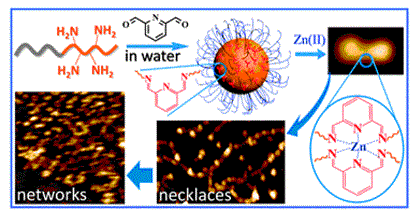(蔡远利)
The Suzhou Key Laboratory of Macromolecular Design and Precision Synthesis, Department of Polymer Science and Engineering, College of Chemistry, Chemical Engineering and Materials Science, Soochow University
Soft Matter, 2015,11, 5546-5553
An emerging strategy towards the sophistication of supramolecular nanomaterials is the use of supracolloidal self-assembly, in which micelles or colloids are used as building blocks. Binding directionality can produce nanostructures with attractive properties. Herein, we present a new directional supracolloidal self-assembly by virtue of dynamic covalent bonds and metal coordination in water. Conjugation of a ligand precursor to a water-soluble block copolymer through dynamic covalent bonds leads to the dehydration and micellization of the functionalized polymer. Reversible reaction facilitates the permeation of metal ions into core–shell interfaces. Conversely, metal-coordination promotes reaction over the interfaces. Cu(II)-coordination occurs overwhelmingly inside each isolated micelle. However, Zn(II)-coordination induced a directional self-assembly whose nanostructures evolve stepwise from nanorods, nanowires, necklaces, and finally to supracolloidal networks scaling-up to several tens of micrometres. Post-reactions of simultaneous dynamic covalent bond conversion and Zn(II)-coordination over the core–shell interfaces endow these supracolloidal networks with a huge specific surface area for hydrophobic dative metal centres accessible to substrates in water. Water-soluble shells play important roles in directional supracolloidal assembly and in the stabilization of nanostructures. Thus the directional self-assembly provides a versatile platform to produce metallo-hybridized nanomaterials that are promising as enzyme-inspired aqueous catalysts.

链接://pubs.rsc.org/is/content/articlelanding/2015/sm/c5sm00546a#!divAbstract